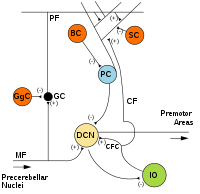
Photo from wikipedia
© Author(s) (or their employer(s)) 2023. No commercial reuse. See rights and permissions. Published by BMJ. A 78yearold man had variable slurring of speech for 1 month, with swallowing difficulty.… Click to show full abstract
© Author(s) (or their employer(s)) 2023. No commercial reuse. See rights and permissions. Published by BMJ. A 78yearold man had variable slurring of speech for 1 month, with swallowing difficulty. His medical history included ulcerative colitis, hypertension, aortic valve disease, ischaemic heart disease and a transient ischaemic attack several years before. On examination, there were rhythmic movements of his palate, with an approximate frequency of 2 Hz (figure 1, online supplemental video 1). There were rhythmic breaks in his voice when trying to sustain a vocal tone (online supplemental video 2). He could not perform tandem gait, but there was no appendicular ataxia. The remaining neurological examination was normal. MR scan of the brain showed hypertrophic degeneration of the inferior olivary nuclei, but with no identified specific cause (figure 2). He was diagnosed with palatal tremor. Palatal tremor (previously palatal myoclonus) is a rare movement disorder characterised by rhythmic contractions of the soft palate. There are two subtypes: essential and symptomatic. Essential palatal tremor is characterised by contractions due to the action of tensor veli palatini, and imaging is normal. Ear clicks are common (they are rare in the symptomatic form), and it stops during sleep in about half of cases. Features such as entrainability and distractibility in some cases may suggest a functional cause. Symptomatic palatal tremor occurs with lesions of the GuillainMollaret triangle (comprising the red and inferior olivary nuclei along with the contralateral dentate nucleus), resulting in contractions of the levator veli palatini muscle. The symptoms often progress and peak within 24 months of the causative insult. It has many causes, including stroke, demyelination, trauma, posterior fossa tumours and vascular malformations. Symptomatic palatal tremor, unlike the essential form, is one of the few movement disorders that persists during sleep. There may be other associated signs such as ataxia, ophthalmoplegia, peripheral tremor, dysarthria and pendular nystagmus. Characteristically, the imaging shows hypertrophic degeneration of the inferior olivary nuclei. The observed hypertrophy probably results from loss of inhibitory (GABAergic) innervation of the inferior olivary nucleus from the contralateral dentate nucleus. Unilateral hypertrophic olivary degeneration usually
Journal Title: Practical Neurology
Year Published: 2023
Link to full text (if available)
Share on Social Media: Sign Up to like & get
recommendations!